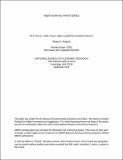Fat Tails, Thin Tails, and Climate Change Policy
Author(s)
Pindyck, Robert S.
DownloadPindyck_Fat tails.pdf (593.8Kb)
OPEN_ACCESS_POLICY
Open Access Policy
Creative Commons Attribution-Noncommercial-Share Alike
Terms of use
Metadata
Show full item recordAbstract
Climate policy is complicated by the considerable uncertainties concerning the benefits and costs of abatement. We do not even know the probability distributions for future temperatures and impacts, making benefit–cost analysis based on expected values challenging to say the least. There are good reasons to believe that those probability distributions are fat-tailed, which implies that if social welfare is based on the expectation of a constant relative risk aversion utility function, then we should be willing to sacrifice close to 100 percent of gross domestic product to reduce greenhouse gas emissions. I argue that unbounded marginal utility makes little sense and that once we put a bound on marginal utility, this implication of fat tails goes away: Expected marginal utility will be finite even if the distribution for outcomes is fat-tailed. Furthermore, depending on the bound on marginal utility, the index of risk aversion, and the damage function, a thin-tailed distribution can actually yield a higher expected marginal utility (and thus a greater willingness to pay for abatement) than a fat-tailed one.
Date issued
2012Department
Sloan School of ManagementJournal
Review of Environmental Economics and Policy
Publisher
Oxford University Press
Citation
Pindyck, R. S. “Fat Tails, Thin Tails, and Climate Change Policy.” Review of Environmental Economics and Policy 5.2 (2011): 258–274.
Version: Author's final manuscript
ISSN
1750-6816
1750-6824